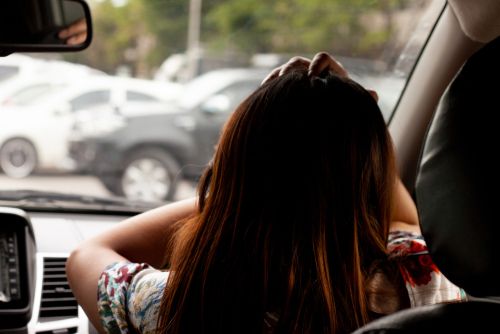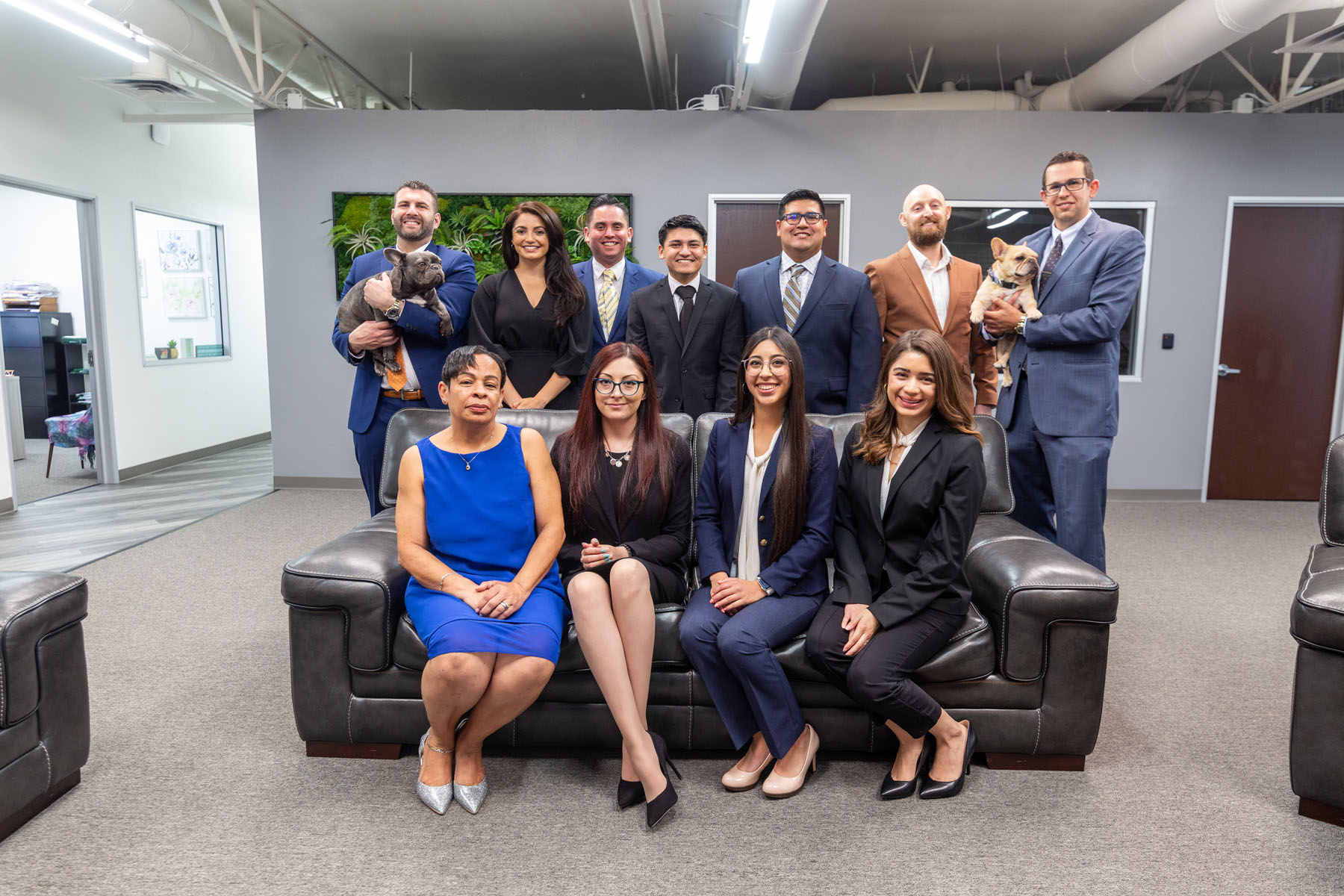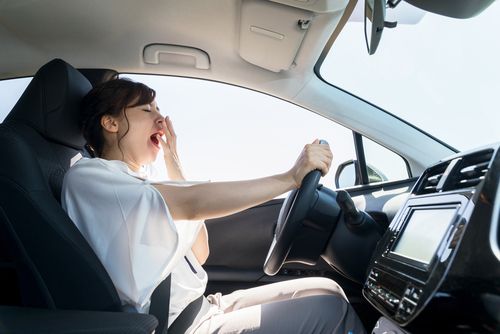Most of us know that texting and driving is growing as a major form of distracted driving. You might say that drowsy driving is the opposite of texting and driving. Whereas drivers who use their cell phones while behind the wheel are active, alert, and distracted, those who get drowsy while driving might do so out of boredom or fatigue. Driving experts often classify drowsy driving as impaired driving. Although the situations are very different, drowsy driving is a big threat to your safety on the road.
What Is Drowsy Driving?
Drowsy driving happens when the driver of a vehicle is too tired or impaired to stay alert. Even if they don’t fall asleep, the drowsy state results in slower reaction times, impaired thinking, and less vigilance for observing traffic conditions. They might drift off to sleep without even realizing they’re sleepy. Knowing the warning signs and how to prevent getting drowsy could save your life and the lives of others.

Causes of Drowsy Driving
Most drivers have experienced the feeling of getting drowsy behind the wheel at some point. It’s a lot more common for some types of drivers and those who have certain medical conditions. Some of the most common causes of drowsy driving are:
Not Getting Enough Sleep – It only takes one night of poor or inadequate sleep to cause drowsy driving. Truck drivers and others who spend extended hours on the roads are at an increased risk. Although the laws have changed to prevent truck drivers from going without sleep, they don’t always follow the rules. People who work at night or who rotate their shifts are also at an increased risk, especially when they drive home after work.
Untreated Sleep Disorders – Obstructive sleep apnea is a condition in which a person stops and starts breathing during sleep. It occurs when the back throat muscles relax and obstruct the airway. The person is unable to reach deep sleep, which is necessary for rest. People who snore, one of the primary symptoms of sleep apnea, or who sleep fewer than 6 hours per day, are more likely to report falling asleep while driving.
A second sleep disorder called narcolepsy can also be behind drowsy driving. Narcolepsy causes a person to fall asleep any time they feel relaxed. Either or both of these conditions increase the risk of drowsy driving while driving either during the daytime or the nighttime.
These aren’t the only sleep disorders that can keep you from getting the quality sleep you need. Nothing helps prevent drowsy driving more than getting enough good quality sleep at night. If you wake up feeling tired or have trouble falling and staying asleep, get to the root of the problem. Sleep is an important part of everyone’s well-being at any age.
Medications – All medications have some side effects associated with them, including increased sleepiness. You might not even realize your medication makes you drowsy until you get behind the wheel.
Young Men – Men in their teens through their thirties are more likely to have drowsy driving-related accidents. They also happen more often between 11 pm and 8 am.
More Drowsy Driving Statistics
The National Safety Council (NSC) is the nation’s leading safety advocate. They collect data and provide safety information and resources for the purpose of preventing injuries and saving lives. According to the NSC, driving after going without sleep for more than twenty hours is the same as driving with a blood-alcohol concentration of 0.08%, which is the legal limit.
The NSC warns that drivers are three times more likely to be in a crash when they are fatigued. The drowsier a driver is, the slower their response time and the less aware of hazards they are. If anyone doubts the seriousness of drowsy driving, the following statistics should have an impact:
- More than 20% of drivers questioned admitted to falling asleep behind the wheel within the past year
- More than 40% admit it has happened at least once during their driving career
- An estimated 5,000 people died during 2015 in car crashes involving drowsy driving
- Based on statistical data from the Governor’s Highway Safety Association (GHSA), 6 million sleep-deprived drivers are in the workplace, at school, and behind the wheel
- There were more than 72,000 police-reported crashes from 2009 to 2013 involving tired drivers
- A separate AAA analysis showed that an estimated 7% of all crashes and 16.5% of fatalities involved fatigued driving
- Drowsy driving causes about 71,000 non-fatal injuries each year
- The monetary loss of drowsy driving-related crashes is about $12.5 billion
Some of the numbers behind drowsy driving are estimates because precise numbers are nearly impossible to nail down. Unless someone admits to being fatigued or overtired, there’s no way to know for sure. Sometimes there are clues that make crash investigators suspect a connection but there’s no way to prove it.
Drowsy driving crashes can happen at any time but some commonalities do exist. More of them occur…
- – Between midnight and 6 am or in the late afternoon. These are the times when people experience dips in their circadian rhythm, which regulates sleep.
- – With single drivers who run off the road at high speeds and show no signs of braking.
- – On rural roads and highways.
Warning Signs
There’s no denying the seriousness of the impact drowsy driving has on everyone on the roads. Not only do drivers need to stay alert to their driving practices, but also to those of other drivers on the road. Since drowsiness often occurs without the driver realizing it, everyone needs to be aware of the warning signs. If you experience any of the signs listed below, don’t ignore them. It’s too late once you fall asleep and cause a car crash.
- – Yawning
- – Daydreaming or having disconnected thoughts
- – Nodding and having trouble keeping your head up
- – Difficulty focusing, heavy eyelids, frequent blinking
- – Missing road signs, turns, or exits
- – Trouble keeping your eyes open
- – Inability to remember the last few miles of driving
- – Drifting into other lanes
- – Hitting the rumble strips on the shoulder of the road
- – Getting close to other cars

Preventing Crashes from Drowsy Driving
The best way to prevent crashes from occurring is by not driving while drowsy at all. Once drivers realize how serious drowsy driving is, they can focus on preventing crashes by preventing the fatigue that leads to it. Drivers often think that rolling down the window and turning up the radio are enough to stave off sleepiness. But the biological urge to go to sleep is a strong one.
- Get a Full Night of Sleep Before Driving
Some sleep isn’t better than no sleep at all. Adults need a minimum of 7 hours while teens need 8 or more. Sometimes excitement or anxiety about the next day’s activities makes it hard to rest. Make sure you follow good practices for falling and staying asleep early and creating a peaceful atmosphere. Stick with a sleep schedule and avoid looking at blue screens and drinking caffeine before bedtime.
- Avoid Driving Late at Night
Your body knows when it’s time to sleep and when it isn’t. Many people prefer to travel at night when there’s less traffic on the roads. Driving at night increases your risk of getting drowsy, making it more dangerous instead of less.
- Get a Travel Buddy
Another person to talk with can help, especially on long trips. Take turns driving and help prevent fatigue from being behind the wheel for extended periods.
- Nap After Drinking Caffeine
Caffeine helps boost your energy and keeps you awake. Take a short nap after drinking it to maximize its effects.
- Take Naps When Needed
If you start to notice the signs of drowsiness, pull over at a rest stop or other well-lit spot to rest. It only takes ten to twenty minutes to alleviate drowsiness and it won’t take that much time out of your driving schedule.
- Get a Ride
If you work the late shift or you haven’t gotten enough rest, arrange for someone else to drive you home. Planning ahead helps reduce your risk of getting drowsy when you’re tired and off-schedule.
- Get Sleep Symptoms Treated
If you have problems sleeping or fall asleep during the day, talk to your physician. Getting diagnosed and treated could do more than help you stay awake while driving. It can improve your quality of life and your general health.
- Avoid Alcohol and Medications That Cause Drowsiness
Many medications cause drowsiness as a side effect. Alcohol only intensifies the effect. Talk to your doctor about other alternatives for those times when you need to drive.
Drowsy Driving and Liability
People often think that drowsy driving is harmless. After all, it’s something that the majority of drivers in this country have done at some time. The reality is that it’s a practice that has serious consequences.
Drinking alcohol has a similar effect on your ability to drive as being sleepy. While there are specific laws against driving under the influence of alcohol or drugs, the same isn’t true for drowsy driving. DUI is a criminal offense that leads to a conviction and license suspension. Drowsy driving, on the other hand, depends on what happens as a result of your condition. It isn’t an automatic violation of the law. You can be charged for reckless driving if you are driving dangerously in California. While this charge is a misdemeanor, you could still serve up to 90 days in jail.
If you cause a car crash and other people get hurt, you are liable for their injuries. You are also at risk of serious charges like vehicular manslaughter. The California Penal Code dealing with these crashes is a wobbler. That means the court might charge you with a misdemeanor or a felony depending on the circumstances. If charged with a felony, you might spend as long as three years in prison. In addition, you could face civil charges for any damages you cause.
Drivers who are drowsy are sometimes confused with those who are impaired. Both exhibit similar symptoms such as running traffic lights, crossing into other lanes, and weaving. Either might have bloodshot, watery eyes or exhibit slurred speech.
If you cause a wreck due to drowsy driving, your liability is the same as if you were fully alert. The same is true for another driver who causes your injuries. The reason they struck your vehicle doesn’t matter. If they are at fault for the wreck, they are liable for paying your damages.
What to Do if You Are Hit by a Driver Who Fell Asleep at the Wheel
If you suspect the driver who hit you fell asleep at the wheel, talk with an experienced personal injury attorney about your case. Proving drowsy driving is often difficult. An attorney knows what to look for, such as a lack of braking or signs that the car suddenly drove off the shoulder or pulled quickly back onto the pavement. Also, note any signs of impairment right after the accident occurs.
There is no excuse for drowsy driving. People know when they feel tired and sleepy. They always have the option to pull over or to not get behind the wheel in the first place. If they have been prescribed medications that cause drowsiness or were driving for extended periods, your attorney can gather evidence to prove the driver was fatigued. Although proving drowsy driving is challenging, it also proves that the driver was negligent and at fault for your damages. It will help you get the compensation you deserve for your injuries.
Batta Fulkerson Can Help
Any time you get injured because of another driver’s negligence, you need the guidance of a personal injury attorney to help you get the compensation you deserve. Whether the wreck is the result of drowsy driving, driving under the influence, or something else, you have rights. Contact Batta Fulkerson for a free consultation today. It doesn’t cost anything to find out if you have a personal injury case.




